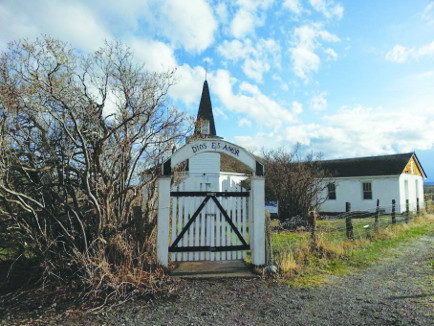History of San Rafael Presbyterian Church

MOGOTE —With Easter on the horizon, the San Luis Valley’s religion comes into focus.
Located in the southern San Luis Valley, San Rafael Presbyterian Church was probably built in 1895-97 and used regularly until 1965. It is the second-oldest church in Conejos County and one of the few historically Spanish-speaking Presbyterian churches in Colorado. In 1999 it was listed on the State Register of Historic Properties, and in the early 2000s it was restored with the help of grants from the State Historical Fund.
When the San Luis Valley was first settled by Hispano migrants from New Mexico in the 1850s and 1860s, its new residents were largely if not entirely Catholic. Presbyterians did not make inroads in the region until about 1875, when they organized a church in Del Norte. From there, Presbyterianism began to spread west to the San Juan Mountains as well as to other towns in the San Luis Valley. From 1875 to 1877, the Rev. Alexander Darley was stationed in Del Norte and distributed copies of the Bible throughout the valley. Soon, churches were organized in Antonito, Cenicero and Alamosa.
In 1854 Hispano migrants moving up the Conejos River from Guadalupe first settled the town of Mogote. Presbyterian missionaries arrived in the 1880s. In 1893, 27 Presbyterian converts in town formed San Rafael Presbyterian Church. In 1895 a Presbyterian mission school opened, and the congregation acquired land on the south side of town for the construction of an adobe church building.
Completed in 1897, the church was a territorial adobe building that employed an unusual mix of architectural features. The main entrance was in a bell tower set at a 45-degree angle on the northeast corner of the church. The lower portion of the tower was adobe, like the rest of the church, but the upper portion had clapboard siding. The main body of the building had a hipped roof instead of the front-gabled roof that is typical for San Luis Valley churches. Inside, the church had plaster walls, wood floors, and twenty-two pews that the congregation fashioned from local timber. Outside, a gate leading from the road had an arch with the words “DIOS ES AMOR” (God is love) painted in large letters.
The congregation expanded San Rafael Presbyterian three times in the first half of the 20h century. In 1911 the rear of the building was lengthened by about 20 feet to add extra space. Sometime in the next two decades a small southern addition was built, which was used as a Sunday school room and children’s nursery. In 1950 the congregation added a north annex, giving the building a T shape.
Presbyterianism spread even more widely in the San Luis Valley after 1878, when the Colorado Presbytery decided to establish 30 mission schools in southern Colorado over the next 15 years, including six in the Valley. The mission schools taught Hispanic children English and also gave them scriptural lessons. The schools were popular for about a generation in the late nineteenth and early twentieth centuries, since they offered an easy way to learn English (and thus entry into the new Anglo economic order in the Valley) in the years before a strong local public school system was established. During that period, Presbyterian mission schools operated in San Luis, La Costilla, Capulin, San Pablo, Ortiz, and Mogote, and Presbyterian churches were established in Capulin, La Jara, Ortiz, San Pablo and Mogote.
At its height in 1920, San Rafael Presbyterian had about 140 members. The congregation declined after the local Presbyterian school closed in 1922, and it shrank even more as younger residents moved to larger cities during the Great Depression and in the decades after World War II. By 1965, the congregation numbered only 30 members and decided to merge with United Presbyterian Church in Antonito, about five miles away. San Rafael Presbyterian continued to be used occasionally into the 1970s, but after that it sat empty and fell into disrepair.
In the 1990s, locals held an annual summer service and picnic in the San Rafael Presbyterian churchyard. By 1998, a committee of former church members led by Margie Garcia started to work toward a full restoration of the building. In 1999 the group got the church listed as a state historic property, and in 2001 the nonprofit Colorado Preservation Inc. named the church one of the state’s “Most Endangered Places” to draw attention to its preservation. Over the next decade, the church was able to secure more than $300,000 in grants from the State Historical Fund. The money went toward the installation of electricity and indoor plumbing as well as repairs to the ceiling, wood floor, and adobe walls. The restoration was finished in July 2010, and the church held a completion ceremony attended by more than 250 people with ties to the area.
Today the restored church is used during the summer for religious services and other events.
This information comes from the online Colorado Encyclopedia



